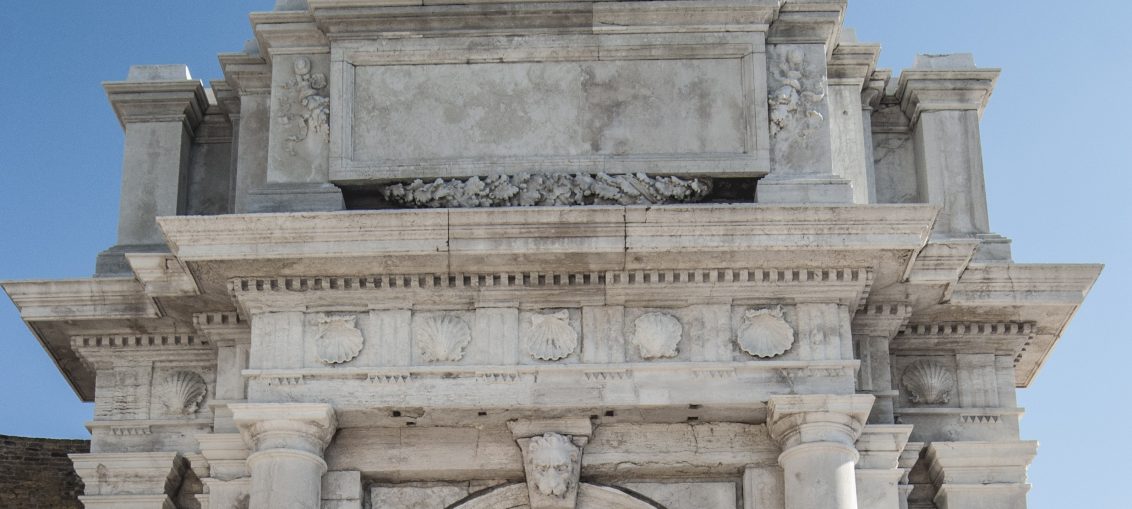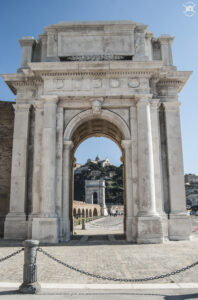
L’Arco Clementino rappresenta una delle testimonianze del periodo dorico dell’architetto Luigi Vanvitelli.

Dedicato a Papa Clemente XII che nel Settecento volle dare nuovo impulso all’economia della città mediante l’istituzione del porto franco. incaricò dunque l’architetto Luigi Vanvitelli dell’ammodernamento delle strutture portuali.
Eretto nel 1738 con l’intento di creare una porta monumentale che nobilitasse “l’accesso alla città e allo Stato Pontificio agli occhi dei mercanti stranieri appena sbarcati”, l’arco segna l’attacco del nuovo molo a quello antico di epoca traianea.
Di ordine dorico, presenta due fronti differenti. In quello rivolto verso il mare, in pietra d’Istria, l’arco, a tutto sesto, è inquadrato da colonne con sovrapposta trabeazione adorna di conchiglie. Il lato verso la città presenta invece un parametro di mattoni a vista, come la cinta muraria del camminamento in cui è inserito il Corridore. Sopra l’attico doveva essere collocata la statua di Clemente XII, scolpita a Roma da Agostino Cornacchini, attualmente situata in piazza del Plebiscito.
Se lo si osserva, immedesimandosi nel navigante appena sbarcato, l’Arco Clementino funziona come cannocchiale visivo verso la città: un punto di vista privilegiato che, attraverso la sua arcata, inquadra l’Arco di Traiano e la cattedrale di San Ciriaco.
Arch of Clement
The Arch of Clement is one of the main works of the architect Luigi Vanvitelli in Ancona. It was dedicated to Pope Clement XII, who in the eighteenth century wanted to boost the economy of Ancona by making it a free port. He also entrusted the architect Luigi Vanvitelli with the modernization of harbour facilities. Erected in 1738 with the intention of creating a monumental portal, to embellish “the access to the city and to the Papal States in the eyes of incoming foreign merchants,” the arch marks the joint between the new pier and the ancient Trajan’s pier.
In Doric order, it has two different sides. The side facing the sea, in Istrian stone, has a round arch, framed by columns with a superimposed entablature decorated with shells. The side overlooking the city has a brick battlement, just like the surrounding walls. The statue of the pope Clement XII, sculpted by Agostino Cornacchini in Rome, must have been on the attic. It is now located in Piazza del Plebiscito.
Watching the arch from the point of view of an incoming sailor, it works as a telescope towards the city: it creates a privileged point of view: within its frame, one can see Trajan’s arch and the cathedral.
Clemensbogen
Der Clemensbogen ist ein Denkmal der Dorischen Epoche, eines der Hauptwerke des Architekten Luigi Vanvitelli in Ancona. Es wurde Papst Clemens den XII. gewidmet, der im 1700 Jahrhundert neue Anreize bot um die Wirtschaft von Ancona anzukurbeln, so machte er Ancona zum Freihafen. Er übertrug dem Architekten Luigi Vanvitelli das Projekt der Modernisierung der Hafenanlagen 1738 mit dem Vorhaben ein nobles Bogendenkmal zu bauen “um den Zugang zur Stadt und Kirchenstaat in den Augen der ankommenden Ausländischen Kaufleute ins Auge zu fallen”.
Der Bogen stellt den Anschluss vom neuen und dem alten geschichtlichen Pier aus der Trajanischen Epoche dar.
Nach der Dorischen Ordnung, hat der Bogen zwei unterschiedliche Vorderseiten. Die Seite die dem Meer zugewand ist besteht aus Istrischen Gestein, der Bogen, einen Rundbogen, der von Säulen umrahmt ist mit überlagertem Balken mit Muscheln verziert. Die Seite die der Stadt zugewand zeigt dagegen die Einflußgröße der Ziegelsteine auf einen Blick, wie die Begrenzungswand an dem Gehweg.
Über die Attika sollte die Statue des Papstes Clemes XII plaziert werden, die in Rom von Agostino Cornacchini eingemeißelt wurde. Derzeit befindet sie sich auf Piazza del Plebiscito.
Betrachtet man es aus der Sichtpunkt eines eben angekommenen Seemannes, dient der Bogen als Fernrohr visuell in Richtung Stadt: ein bevorzugter Blickpunkt, der durch seine Arkade umrahmt den Trajansbogen und die Kathedrale von San Ciriaco.
